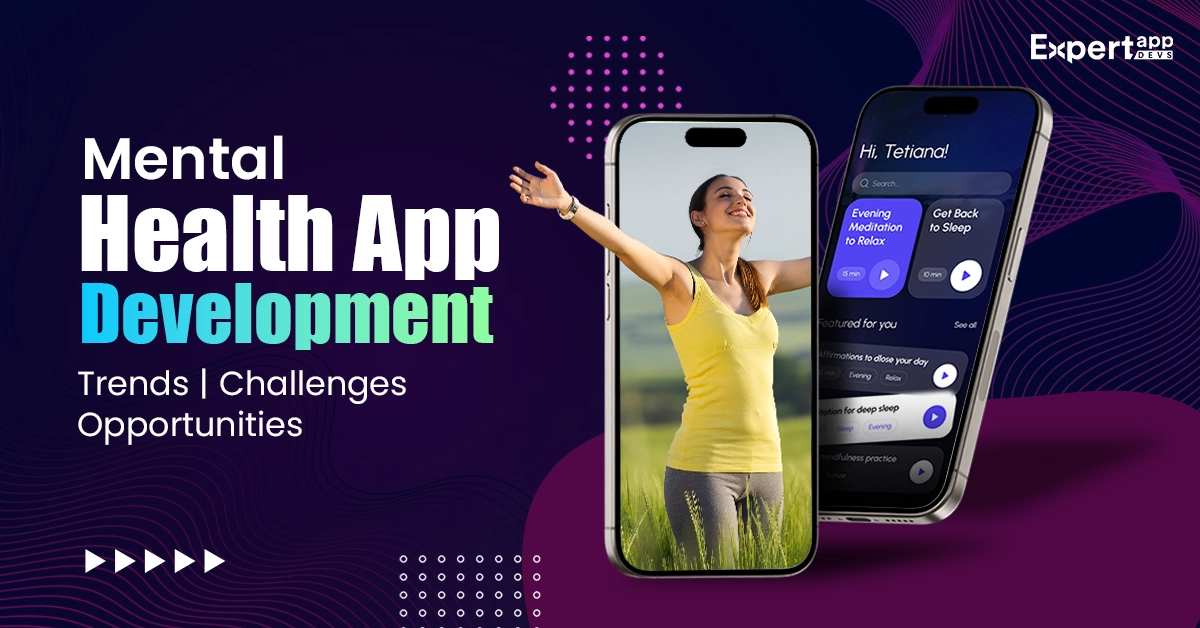Mobile Apps for Mental Health: Trends, Challenges, and Opportunities
In those quiet moments when there is a turbulent storm within, mental health apps can offer a beacon of solace. These digital companions understand these overwhelming feelings and offer the perfect support.
For those people aching from mental health issues, these apps are not just lines of code. They are their lifelines, supporting them through the emotional turmoil.
With the heightened awareness surrounding mental health issues, the landscape has evolved with apps. Consumers spent $372 million on mental health applications in 2021. The total market size was $6.2 billion in 2023 (GrandViewResearch).
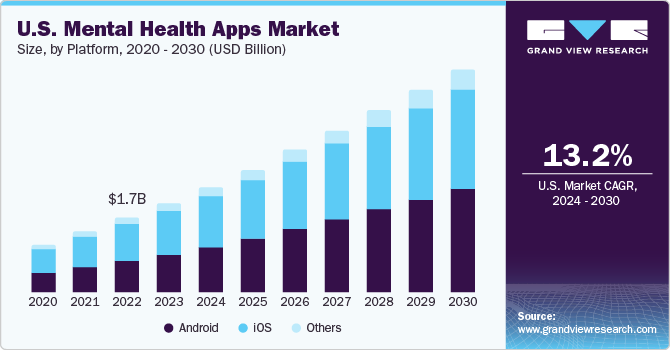
These numbers indicate a growing need for mental health solutions to address burnout, stress, anxiety and other conditions. As more people are opening up, you must build confident solutions to help them combat their inner battles.
Your applications should embed compassion within the pixels and weave hope into the algorithms to enhance engagement. You can use this guide if you plan to embark on a journey to build a sanctuary for your users.
This article will explore the current scenario, exploding trends and best practices for mental health app development.
Mental Health Apps: A Multifaceted Landscape
Several innovations and trends are shaping the well-knit mental health landscape to enhance your user’s emotional well-being.
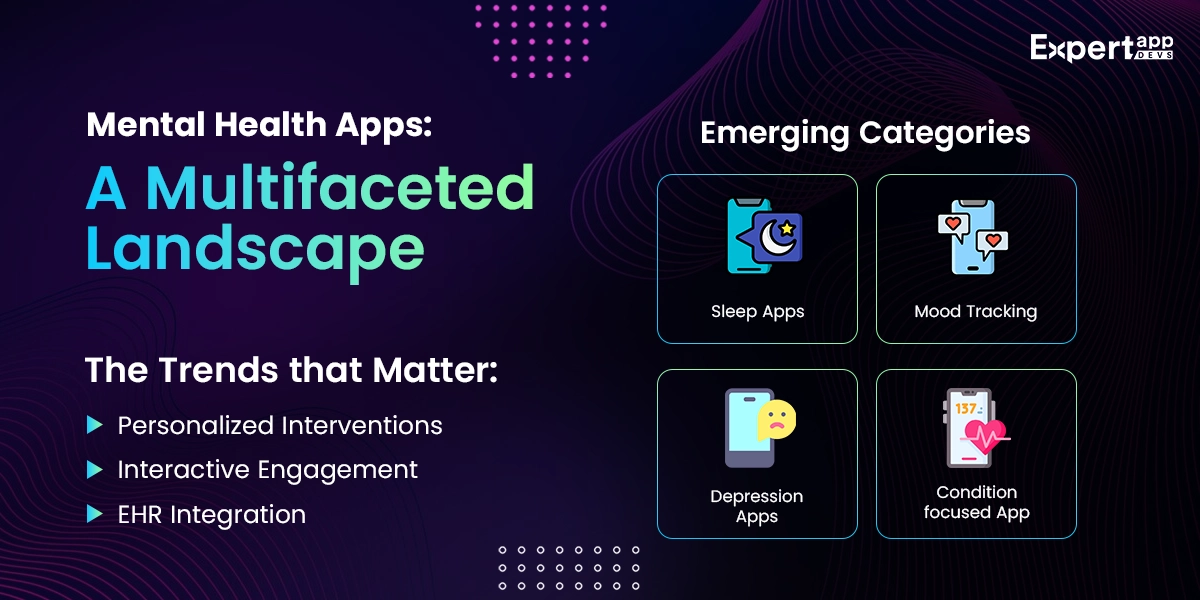
The Trends that Matter:
#1. Personalized Interventions
Mobile apps for mental health integrate with Artificial Intelligence to craft data-backed insights. The data can also help power a personalised algorithm for better recommendations and suggestions.
Moreover, it can help personalised mindfulness solutions and cognitive behavioural therapy for your users. This can improve their experience and help them accomplish their well-being goals.
#2. Interactive Engagement
Businesses have added interactive elements to mental health apps that can encourage engagement. Users gain conversational support to help them move in the right direction. Wearable integration allows users to track their daily lives and activities for better emotional health.
Moreover, you can use gamification strategies to make the journey rewarding. This would get more people to work on improving their mental health.
#3. EHR Integration
Mental health applications deal with sensitive data about the users. While a seamless flow of data is crucial, it is equally important to maintain confidentiality.
EHR integration can help ensure confidentiality while relaying the information to caregivers and practitioners. It will enable the apps to guide the users with the right insights and data. Moreover, the integration will ensure the data collection is done using industry-specific compliances and regulations.
Emerging Categories:
You must deliver your apps keeping these trends in mind. Additionally, your apps should also support these emerging categories or innovative practices for better engagement.
✅ Sleep Apps
Businesses are planning app solutions that focus on sleep quality. These apps can help users plan their sleep schedules and provide personalised relaxation methods. This would help improve the balance between the user’s sleep and mental health.
✅ Mood Tracking
The apps can help track your user’s mood via mental health app solutions. These applications use data-backed insights to develop the patterns. They can also use the fluctuations and triggers to develop algorithms to personalise the self-improvement strategies.
✅ Depression Apps
Users can combat the depression complexities with mental health solutions. These apps can incorporate therapeutic interventions and mood tracking to improve the user’s healing journey. These apps identify the unique requirements of a depressed individual and offer the appropriate solutions.
✅ Condition-focused Applications
The users could be facing specific mental health conditions. Your broad-category apps may not address these specific conditions. The condition-focused solutions will unveil the specific requirements to build a powerful application.
Opportunities and Potential of Mental Health App Development
As the mental health app landscape evolves, it assures to close the existing gaps. Using these potentials and opportunities, you can make the applications accessible. You can even foster collaborative care for mental well-being.
#1. Bridging the Gap
The traditional mental health care opportunities were limited to fewer locations. People living in specific areas could access the care.
However, mental health app solutions can reach users beyond the traditional geographies. They have blurred the geographical barriers to unleash the resources and make them available.
- These mobile apps for mental health can foster outreach programs to eliminate the disparities in accessing care.
- They can even ensure the availability of caregivers in remote lands.
- Using self-assessment tools, the patients can assess their mental health conditions.
- It also aims to offer proactive intervention, which can help you access timely support and improve your condition.
#2. Empowering Individuals
It has become crucial for individuals to understand the importance of mental health and well-being. They must avail the tools that can transpire this journey.
Mental health apps can empower individuals with the right solutions for well-being. They offer guided meditation solutions and stress management techniques. Additionally, you will get mood-tracking or goal-setting solutions.
- In an attempt to educate users with mental health and well-being solutions, several apps have been converted into virtual classrooms.
- These apps extend the appropriate resources and materials to help the users make informed decisions.
- There are algorithms that back the user’s data to offer personalised interventions. This would support the user’s journey.
- They can also offer impactful strategies to deliver effective support.
The idea behind these applications is to remove the stigma associated with mental health issues.
#3. Supporting Professionals
Mental health apps are useful to your patients. However, you cannot deny their importance in the professional’s life. These apps can help enhance the communication and transparency between the patient and the caregiver.
They will help build an environment conducive to virtual mental health therapy sessions. Moreover, these platforms can enable fast and seamless data sharing for prompt responses.
- You can integrate the apps with EHR to ensure seamless and secured data transfers.
- You can improve the collaboration between healthcare professionals and your users for insightful interventions.
- It can also help professionals manage their routine tasks. It improves resource and time allocation.
- Moreover, these apps can help enhance workflow efficiency and care management.
Challenges and Considerations of Mental Health App Development
We have seen the opportunities presented to startups and individuals by the landscape. Let’s look at the challenges you cannot escape while crafting mental health solutions. We will be taking you through the tips to overcome these challenges.
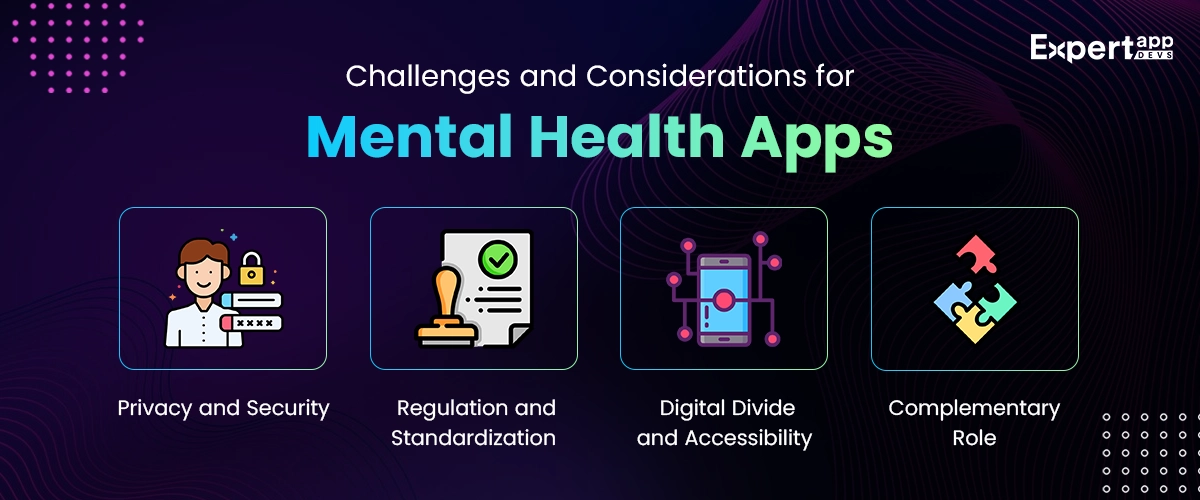
#1 Privacy and Security
There are three aspects to privacy- protecting the data, ethical responsibilities and addressing the risks.
- Data Protection: Mental health apps must protect the user’s data and maintain confidentiality. You must use robust encryption with data protection methods while sharing sensitive information.
- Ethical Responsibilities: You can ignore the ethical aspects while developing an app that can put you on the spot. You must always create an ethical decision-making framework to prioritise your responsibility towards the users. Your app should deploy measures to safeguard sensitive information against misuse.
- Risks and Vulnerabilities: If you have not identified the bugs and issues, your app may succumb to cyber threats and risks. You must always address these issues and plan a risk mitigation strategy. The idea is to foster transparency with your app solutions.
How Companies Have Responded to this Challenge?
- MyFitnessPal, a fitness application, faced a data breach incident in 2018. This incident exposed the user’s information, including their usernames and passwords.
- The company responded to this issue by maintaining transparency with their users. They notified the users and encouraged them to change the passwords. additionally, they introduced protocols to help secure the personal data.
- Headspace overcomes this challenge of data security and ethical responsibilities with advanced encryption strategies. They have an opt-in form that mentions how the data will be used and seeks consent from the users.
- Implementing standard practices can help overcome this challenge and mitigate the risks associated.
- Conduct frequent security audits to address the vulnerabilities in the system
- Implement end-to-end encryption in your systems to protect your user’s data
- Ensure complete compliance to data protection laws such as HIPAA and GDPR
- Respect your user’s privacy and adhere to the defined ethical guidelines
#2. Regulation and Standardization
You cannot put your best foot forward unless you adhere to the compliances. There are specific industry guidelines and standards that you must follow. Here are a few challenges you may face while complying with them.
- You may feel like you are wandering a complex maze if the guidelines are not specific and clear.
- Moreover, if there is an ambiguity surrounding the mental health app standards, it will reflect in the development. It can complicate the entire process.
- It is a constant process to keep a balance between innovation and standards. You can get lost in your innovation and forget to ensure adherence to guidelines. This is a crucial aspect of development. Ensure to implement the quality and reliability standards to innovate the applications.
How Companies Have Responded to this Challenge?
- TalkSpace is a reputed online therapy application. They have collaborated with the regulatory bodies to define the guidelines for this application. Additionally, they have discussed with policymakers to implement industry-specific guidelines in the app
- BetterHelp has collaborated with professionals and regulatory bodies to craft the guidelines. They are abreast with current regulations that reflect in their policies and standards
You can implement these standard practices to respond to these challenges and mitigate the risks.
- Advocate simple and clear guidelines for your mental health applications
- Stay updated about the new regulations and implement these compliances proactively. This will ensure perfect alignment with your legal considerations
- collaborate with industry leaders to craft the policies to overcome the specific challenges
- Assess the quality of your app and its adherence to the regulations for a smooth user experience.
#3. Digital Divide and Accessibility
The “one-size-fits-all” philosophy needs to take a backseat. As you are nurturing diverse users and offering capable solutions, you must look at their requirements.
- Equal Access: All users must be able to access the technology. Whether your user has motor issues or is visually impaired, the design should be accessible. It can be challenging to deliver equal access to your mental health apps. You might want to identify the diversity of your users before planning the solution.
- You must empower your users with the right technology: You must deliver an inclusive application that caters to all cultures and demographics.
How Companies Have Responded to this Challenge?
- WhatsApp partnered with the Brazilian government to make mental health support accessible to everyone during Covid-19. As the platform is accessible, it can enhance your reach and visibility
- 1mg uses a multi-faceted approach to extend teh technological benefits to all users in the target market.
You can implement these standard practices to overcome these challenges.
- You can collaborate with local government and regulatory bodies to engage in outreach programs.
- Implement offline functionality in your application to accommodate users who have limited internet connectivity.
- You must plan the educational resources to help users achieve mental health literacy. This would help them use the applications wisely.
- Offer multi-lingual support so that users across geographies can use your application.
#4. Complementary Role
No one can replace your doctor or caregiver. Apps can support your user in their mental well-being journey. However, they cannot replace the therapist. This should be your premise for developing mental health care applications. You must create an app that can support your professionals. It should enable access in the virtual environment. It should not take up the protagonist’s role. This is a huge challenge for the developers.
You must constantly enhance the user’s understanding of the mental health realm. Using supportive documents and proper information, you can help them understand the nuances of this journey. However, the biggest challenge is to create documents that explicitly explain without overwhelming the users.
How Companies Have Responded to this Challenge?
- Headspace has positioned itself as a complementary solution to the traditional mental health care space. It mentions that meditation and mindfulness in collaboration with traditional mental health services can offer the required solution. They advice the users to take a holistic approach.
- Woebot is an AI-based mental health tool that has explicitly mentioned it is a supportive solution. You cannot replace professional help with these bots.
You can implement these standard practices to overcome the challenge.
- Encourage your users to seek professional help
- Offer resources that can help them understand their health better and seek the best support
- Clearly communicate the purpose of your application to the users.
Best Practices for Mental Health App Development
You must invest in the best development practices to align your mental health applications with the target market. We will discuss the core practices for this segment.
- Your users share a lot of private and secure data. You must ensure adherence to data protection and privacy laws to ensure robust security. You can also lay out the encryption methods to protect the sensitive information. Communicate the privacy policies and terms properly on the application.
- Create a user-centric design to deliver a usable and intuitive interface. You must also identify and create the feedback loops. Additionally, plan your app to meet the diverse user requirements for inclusivity.
- Use evidence-based practices to guide your mental health app development. You must collaborate with the professionals in this industry to deliver an accurate and effective application.
- You must adhere to accessibility standards. WCAG is a crucial accessibility standard you must implement in the application.
- You must personalise the application to meet unique user preferences. You must also set goals and define personalisation to track the progress and monitor the goals achieved.
- You must implement real-time monitoring solutions to support your users’ mental health and well-being needs. You must also find ways to keep track of their health via check-ins and feedback.
- Your app should offer a crisis response plan. This will help the users know who to contact in case of emergencies.
Collaborate with licensed therapists and counsellors to continuously improve the app’s content and features.
- You must maintain the app continuously to augment the security. Continuous updates with newer features can keep the user engaged.
- You can inspect the app by conducting audits. Use the latest research and recommendations to maintain the app.
- Make sure to state the purpose of your app to the users. Add educational materials to help your users know your app better. Explain the application’s purpose and pre-determined details before seeking the user’s consent.
Success Stories of Mental Health Apps
We will look at some of the popular mental health app categories and their success stories to understand this landscape better.
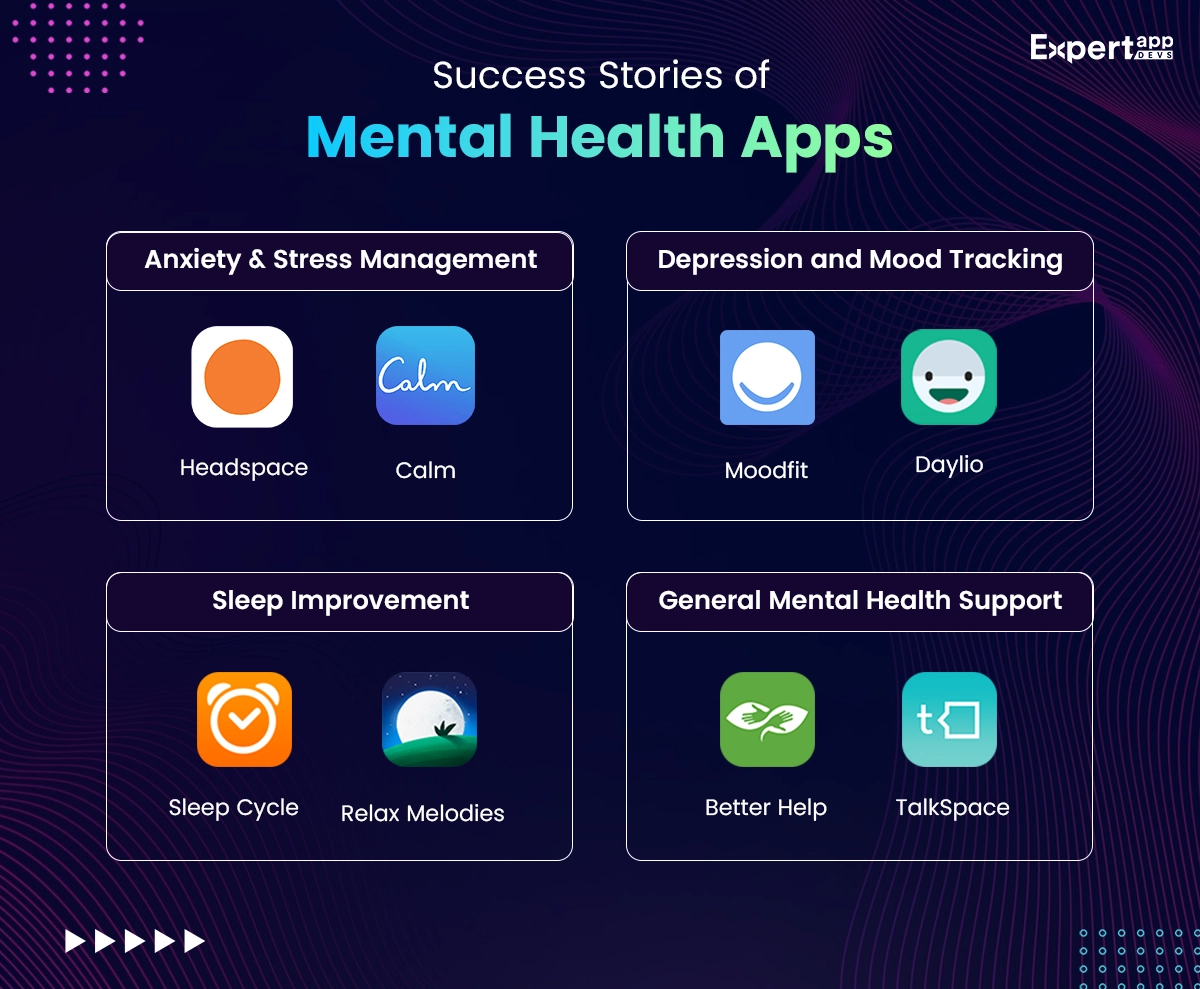
#1. Anxiety and Stress Management
- Headspace: This app extends guided meditation exercises to help users manage their anxiety and stress. This can help manage overall well-being. It is a premium application.
- Calm: This application offers meditation sessions and relaxation techniques to help manage stress and anxiety. It is a freemium application.
#2. Depression and Mood Tracking
- Moodfit: Users can track their mood throughout the day with this application. The features can help users be more self-aware and augment their emotional well-being. It helps improve self-awareness among the users. They offer a freemium version.
- Daylio: You can use the application to journal your mood and track it better. It can help users be aware of their emotions. You get both free and premium versions of the app.
#3. Sleep Improvement
- Sleep Cycle: If you have been facing sleep cycle issues, you can choose this application. Users can improve their sleep quality using insight-backed patterns.
- Relax Melodies: They offer calming sounds and meditation routines to relax the patients and improve their sleep.
#4 General Mental Health Support
- BetterHelp: Your app allows users to connect with licensed professionals and therapists for online counselling. It makes mental health support accessible.
- TalkSpace: This app allows your licensed therapists to connect with their patients via video calls, messages and chats.
Mental Health App Development Process
You must follow a development process that tracks the product from the concept stage to its marketing.
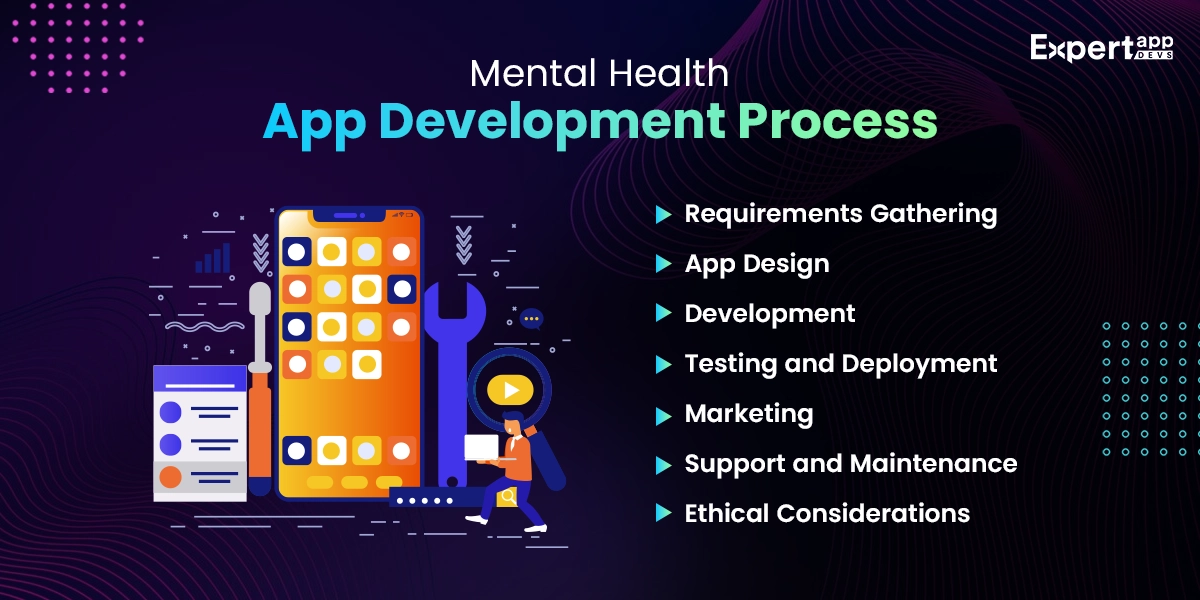
#1. Requirements Gathering
The purpose is your north star in the convoluted mental health app development realm. It will address the concerns of your users and define the paint points. During the requirements gathering phase, you must also define the target audience, and study your competition.
This would help you propose the app requirements and the scope of work. To delve deeper into your purpose and determine the goals, you must conduct detailed research. You will know the gaps in the industry, and can determine the solution.
You can even collaborate with the practitioners to create the appropriate solution. Before proceeding with design, you must also study the guidelines and compliances for the industry.
#2. App Design
The first step to a successful design is defining the user’s persona. You must consider all the different audience segments to prepare the persona.
You must design the interactions for these different personas to make the app accessible. Once you have created the design strategy, you can create the wireframes and prototypes. Start with designing the skeleton for the application. Use it to deliver a low-fidelity and then a high-fidelity prototype.
You must ensure your interface design is in sync with the UX and UI design strategies. Adhering to accessibility guidelines can help transpire an inclusive solution.
#3. Development
You must work with the best technologies for guided development. Choose the frameworks for backend, frontend and database development aligned with your vision. Your framework choices will depend on the targeted platform.
You must look at the current apps and the ecosystem to plan the features and functionality. It will also guide you towards real-time monitoring and response solutions.
While developing the mobile application, you must ensure proper encryption methods and data protection guidelines. You must also connect with the providers of mental health care to seek validation.
#4. Testing and Deployment
You must test your application for vulnerabilities and address the bugs. As you are working on a sensitive landscape, you must conduct a detailed security validation. Additionally, you must check for compliance adherence.
You must also leverage automated and manual tests to validate the application and fix the bugs. You can check if the app is usable, functional and interactive.
You must prepare your application for app store submission. Check if your app adheres to the guidelines specified. You can also prepare the screenshots and images needed to deploy your app. Having a robust app launch strategy is crucial.
#5. Marketing
You must widen your app’s reach to increase the downloads. Marketing can help you ensure maximum visibility. You must plan an all-inclusive promotional strategy that can improve targeting and conversions.
Leverage marketing platforms such as social media and email to connect with your audience. You can also collaborate with influencers to acquire more users.
Define the objectives of your promotional strategy to maximise your reach and visibility.
#6. Support and Maintenance
Supporting your users with quick responses to their queries is essential. You must have a responsive customer support team that can help your users with bugs and their feedback. It is equally crucial to maintain the app and update it as needed.
Your team should also enhance the application with new features and content.
#7. Ethical Considerations
You must clearly state the app’s purpose and your data collection methods. You should also state how you aim to use the data provided by the users. Be transparent about your privacy policy and other information-related laws.
It should contain all the emergency contact information. You must ensure that your app is inclusive and sensitive to all cultures.
Conclusion
Responsible and ethical mental health app development is no longer a technological endeavour. It is a commitment towards the well-being of your users who are dealing with the complexities of their minds.
You must delve into evidence-based practices to inspire trust and reliability on your platforms. Collaborating with experts in the mental health segment can influence credible and exceptional solutions.
It is equally vital for organisations and mental health practitioners to hold dialogues to transpire effective solutions. They must uncover the numerous opportunities and create adaptive solutions.
Expert App Devs is an orchestrator of this dynamic collaboration that can deliver fruitful Healthcare solutions like Telemedicine Apps, Healthcare Marketplace Concierge Applications, On-Demand Medical Services Applications and more. We can develop committed, precise and responsible app solutions using clinical insights, future-driven trends and innovation.
With our expertise and experience, we can share the future of the mental health segment. If you have an idea you believe can further the realm, connect with our team via email or chat.
 Jignen Pandya
Jignen Pandya
